Blogged by Brad Friedman from on the road...
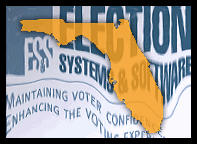 To be clear, despite the headline, we don't mean to call Princeton's computer science professor Ed Felten "stupid" by any means. We do, however, mean to make clear --- in no uncertain terms --- that the oft-floated idea that adding so-called "paper trails" to failed, paperless ES&S touch-screen voting machines, such as those used in last November's U.S. House race in Sarasota between Christine Jennings (D) and Vern Buchanan (R), would not have avoided the situation we're now in. In fact, such "Voter Verified Paper Audit Trails" (VVPAT) added to Direct Recording Electronic (DRE/touch-screen) systems would likely make our current crisis of democracy worse instead of better.
To be clear, despite the headline, we don't mean to call Princeton's computer science professor Ed Felten "stupid" by any means. We do, however, mean to make clear --- in no uncertain terms --- that the oft-floated idea that adding so-called "paper trails" to failed, paperless ES&S touch-screen voting machines, such as those used in last November's U.S. House race in Sarasota between Christine Jennings (D) and Vern Buchanan (R), would not have avoided the situation we're now in. In fact, such "Voter Verified Paper Audit Trails" (VVPAT) added to Direct Recording Electronic (DRE/touch-screen) systems would likely make our current crisis of democracy worse instead of better.
As we've said before, DREs with or without a VVPAT are a threat to democracy. VVPATs are little more than a band-aid at best, and more likely serve only as a panacea to offer a false sense of security.
Adding a "paper trail" to a DRE/touch-screen system is like requiring a seat belt in a Ford Pinto; what good will the seat belts do when the Pinto explodes?
Today then, Princeton's Felten (he of the infamous Diebold Touch-Screen Virus Hack) has posted an article on his blog looking at what may have happened in the contested U.S. House race in Florida's 13th Congressional District between Jennings and Buchanan, in which some 18,000 votes seem to have disappeared completely on the paperless ES&S touch-screen voting machines. Just 369 votes separate the two candidates in the flawed state-certified final results.
In his essay, the first of a promised series to come this week, Felten correctly points out that the situation can only be attributed to problems with the ES&S voting machines themselves, since the undervote rate for the very same race in the very same county was a reasonable 2.5% on the paper absentee ballots, but jumped nearly 15% as recorded on the ES&S touch-screen machines.
Even ES&S's only expert witness so far to take the stand --- Dartmouth College's political (not computer) scientist, Michael Herron --- in the election contest down in Florida admitted that were it not for problems voters encountered in using those voting machines, Jennings likely would have been named the winner. That point was reported by Sarasota Herald Tribune who reported on the testimony this way: "Had those ballots been cast without problems, Jennings would have won by as many as 3,000 votes, according to the ES&S expert's statistical 'best guess.'" Reporting from both Wired News and our own discussions just after the testimony with Lowell Finley, the attorney for VoterAction.org, one of several non-partisan groups who argued the case on behalf of the Florida voter plaintiffs who joined Christine Jennings in filing an election contest, confirmed that point as well.
So the question --- for those legitimately trying to figure out what went wrong, as opposed to Buchanan and his supporters who simply want to claim the House seat as their own, even if it's an aberration of democracy --- is whether the problem was due to bad ballot design, machine malfunction, or, most likely, some combination of both. With just 369 votes between the two candidates in the state-certified final result (which is being challenged in both Florida courts and the U.S. House), virtually every analysis has determined that even a minor machine malfunction would likely have thrown the race to the Republican in the Democrat's strongest areas in Sarasota. That's where the largest undervote rates occured.
 Felten's thesis, however, as he begins to discuss today in his first article on the topic, would seem to suggest --- incorrectly, in our view --- that a "paper trail" on those paperless touch-screens would have avoided this problem. We'll answer by suggesting it would only have made it worse.
Felten's thesis, however, as he begins to discuss today in his first article on the topic, would seem to suggest --- incorrectly, in our view --- that a "paper trail" on those paperless touch-screens would have avoided this problem. We'll answer by suggesting it would only have made it worse.
In the meantime, an as-yet under-reported affidavit obtained by The BRAD BLOG from a poll worker, which accompanied a complaint filed by a Republican (yep, you read that right) in Sarasota who believes machine malfunction was clearly the culprit, seems to demonstrate clearly that a problem with the ES&S iVotronic system, not a problem finding the race on the ballot, was to blame for the massive undervote rate.
Couple that with two excellent reports from Daniel Hopsicker as filed last week (one here, the second here) analyzing, in crystal-clear detail, a number of contemporaneous news reports from Sarasota before, during, and after the election, it becomes very clear that machine failure was the problem in the FL-13 election and not "bad ballot design" --- the favored theory of folks hoping to keep the "provisionally seated" Buchanan in power.
Hopsicker's excellent review of those news reports, both as the problem was first emerging and just after the election, when voters' and poll workers' recollections were still fresh, reveals that voter and poll worker complaints at that time overwhelmingly focused on problems voters had casting their votes in particular races and not on problems finding particular races on the ballots!
We'll take a look at the complaint filed by the Republican mentioned above, along with the poll-worker affidavit, in a future report this week. But for now, we'll look at Felten's "Paper Trails Would Have Avoided the Problem" theory.
As Felten averred today...
Felten's thesis here --- not uncommon for "paper trail" (versus paper BALLOT) supporters who still contend that such touch-screen voting systems, if only they included an attached "reel-to-reel" printer on the side, would accurately reflect voter intention --- is flawed.
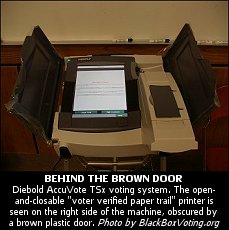 Numerous studies of such "Voter Verified Paper Audit Trail" (VVPAT) equipped systems, such as one done after Cuyahoga County's disastrous 2006 Primary Election using Diebold's VVPAT touch-screen system, have demonstrated that such "paper trails" rarely reflect the internal machine count accurately. More to the point, however, we have seen time and again that voters simply do not check the so-called VVPAT before votes are cast by the touch-screen machines. In some cases, the machines do not make it obvious that the voter is supposed to do so. In other cases --- such as with Diebold's infamously bad opaque plastic door which covers the tiny VVPAT view window, requiring the voter to know to lift it and view the VVPAT with the provided magnifying glass --- voters have been instructed by pollworkers specifically to not lift the door to look at their VVPAT before the "vote" is "cast" by the machine...not by the human. Here's one such example in a PBS News Hour video taped during California's primary election in San Joaquin County, including the transcript in which the poll worker tells both voters and the PBS reporter that votes are to be confirmed "on the computer screen" and that the "paper trail" is "for the people at the office."
Numerous studies of such "Voter Verified Paper Audit Trail" (VVPAT) equipped systems, such as one done after Cuyahoga County's disastrous 2006 Primary Election using Diebold's VVPAT touch-screen system, have demonstrated that such "paper trails" rarely reflect the internal machine count accurately. More to the point, however, we have seen time and again that voters simply do not check the so-called VVPAT before votes are cast by the touch-screen machines. In some cases, the machines do not make it obvious that the voter is supposed to do so. In other cases --- such as with Diebold's infamously bad opaque plastic door which covers the tiny VVPAT view window, requiring the voter to know to lift it and view the VVPAT with the provided magnifying glass --- voters have been instructed by pollworkers specifically to not lift the door to look at their VVPAT before the "vote" is "cast" by the machine...not by the human. Here's one such example in a PBS News Hour video taped during California's primary election in San Joaquin County, including the transcript in which the poll worker tells both voters and the PBS reporter that votes are to be confirmed "on the computer screen" and that the "paper trail" is "for the people at the office."
In other words, a great deal of evidence suggests that voters don't actually bother to look, for a number of reasons, at the VVPAT before the "vote" is cast. And when they do, most such VVPATs are so small and difficult to read that even when they bother to do so before finalizing their vote, it would be extremely difficult to notice a single undervoted race on a long ballot such as the one which occurred with alarming frequency in Sarasota.
Ultimately, the only difference in the FL-13 race, had those ES&S iVotronic touch-screen been equipped with a VVPAT printer, would be that there would likely have been no challenge to the election results --- since those interested in undermining democracy in favor of their candidate would simply have pointed to the "paper trails" as confirmation that voters purposely chose note to vote in the race. The "paper trails" would have simply underscored the machine-reported results, underscoring the unsupported notion that Sarasota voters using touch-screen machines, differently from all other voters in the race in other counties and using other voting systems, actually chose not to vote in that particular election.
With less than 400 votes separating the final reported margin and some 18,000 votes in question, there is little doubt that 369 voters would have failed to properly confirm their vote, for whatever reason, on a dangerous and difficult-to-use "paper trail" on the same touch-screen type of voting machine. End of challenge --- but not an end to unaccountable democracy.
Allowing the use of such DRE (Direct Recording Electronic) devices in an election --- with or without VVPAT printers --- is a recipe for continuing voter disenfranchisement and democratic disaster. Too many legislators, election integrity advocates, and even computer scientists such as Felten, it seems, believe and/or hope that such a technical "solution" would avoid problems such as those revealed by FL-13. Rather, it would help only to avoid legitimate official challenges to the accuracy of such races. It would not however, avoid questions about the accuracy of the results themselves.
Institutionalizing DRE's with VVPATs, as we head into yet another Presidential Election year, is an extraordinarily dangerous direction for American democracy --- even as several soon-to-be-introduced Congressional bills may be set to do precisely that.
We hope Felten will take a close look at that perspective as he continues his series of articles this week, in preparation for the "joint talk on the topic next week" to which he refers in his piece (have a feeling that "joint talk" may be Congressional testimony, but we'll see). A scientific review of these points, particularly in front of Congress and from someone with Felten's credentials, would undoubtedly shed welcome light on both what happened in Sarasota's election and what is required to help assure accuracy, transparency, and accountability in future American elections.
We believe democracy cannot even begin to achieve accuracy, transparency, and accountability without a paper BALLOT --- not a "trail" or a "record" --- for every vote cast. Coupled with appropriate audits of same, and several other needed security measures, we can begin to restore democracy to America. With DRE's in play, however, with or without a so-called VVPAT, that cannot and will not happen.
An Open Letter to Congress, stressing that point, was endorsed, signed, and delivered by more than 40 non-partisan election integrity organizations just before the holidays last December. The BRAD BLOG urges you to sign on to that letter and send it to your congress members. One of the initial signatories, VelvetRevolution.us, has made it easy for you to do so right here.


 Vets Push Back at Trump, Musk Plan to Slash Health Care, 80K V.A. Jobs: 'BradCast' 3/27/25
Vets Push Back at Trump, Musk Plan to Slash Health Care, 80K V.A. Jobs: 'BradCast' 3/27/25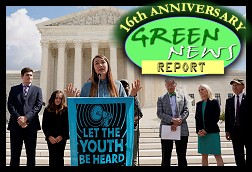 'Green News Report' 3/27/25
'Green News Report' 3/27/25
 Signal Scandal Worsens for Trump, GOP; Big Election Victories for Dems in PA: 'BradCast' 3/26/25
Signal Scandal Worsens for Trump, GOP; Big Election Victories for Dems in PA: 'BradCast' 3/26/25 'Emptywheel' on Why Trump NatSec Team Should 'Resign in Disgrace' After Signal Chat Debacle: 'BradCast' 3/25/25
'Emptywheel' on Why Trump NatSec Team Should 'Resign in Disgrace' After Signal Chat Debacle: 'BradCast' 3/25/25 'Green News Report' 3/25/25
'Green News Report' 3/25/25 Postal Workers Union Prez: USPS 'Belongs to the People, Not the Billionaires':
Postal Workers Union Prez: USPS 'Belongs to the People, Not the Billionaires':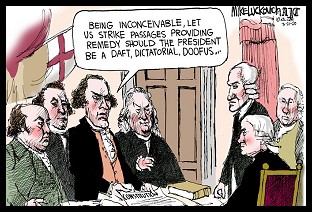 Sunday 'Suddenly Conceivable' Toons
Sunday 'Suddenly Conceivable' Toons We're ALL Voice of America Now: 'BradCast' 3/20/25
We're ALL Voice of America Now: 'BradCast' 3/20/25 'Green News Report' 3/20/25
'Green News Report' 3/20/25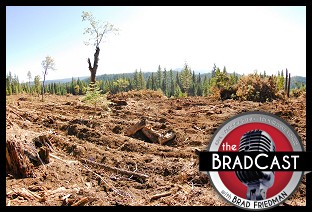 What Trump's 'Timber Production Expansion' Means (and Costs): 'BradCast' 3/19/25
What Trump's 'Timber Production Expansion' Means (and Costs): 'BradCast' 3/19/25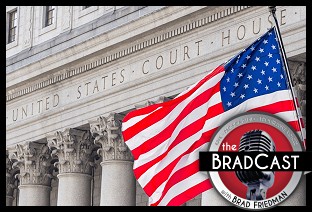 Courts Largely Holding Against Trump, Musk Lawlessness: 'BradCast' 3/18/25
Courts Largely Holding Against Trump, Musk Lawlessness: 'BradCast' 3/18/25 'Green News Report' 3/18/25
'Green News Report' 3/18/25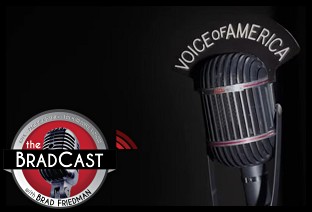 Chief VOA Reporter on Outlet Falling Silent First Time Since 1942: 'BradCast' 3/17/25
Chief VOA Reporter on Outlet Falling Silent First Time Since 1942: 'BradCast' 3/17/25 Sunday 'The Usual' Toons
Sunday 'The Usual' Toons 'Green News Report' 3/13/25
'Green News Report' 3/13/25 Trump EPA Unveils Plans to Endanger, Sicken Americans: 'BradCast' 3/13/25
Trump EPA Unveils Plans to Endanger, Sicken Americans: 'BradCast' 3/13/25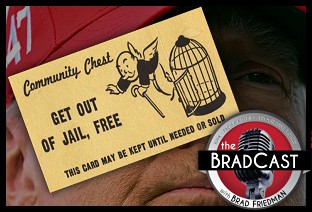 Trump Nixed Enforce-ment Against 100 Corp. Lawbreakers: 'BradCast' 3/12/25
Trump Nixed Enforce-ment Against 100 Corp. Lawbreakers: 'BradCast' 3/12/25 Bad Day for 'Strongmen': 'BradCast' 3/11
Bad Day for 'Strongmen': 'BradCast' 3/11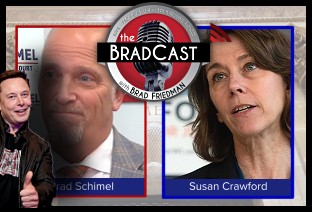 WI Election Could Flip Supreme Court Control, Musk Jumps In: 'BradCast' 3/10
WI Election Could Flip Supreme Court Control, Musk Jumps In: 'BradCast' 3/10 'What Else Could a Russian Asset Do That Trump Hasn't?': 'BradCast' 3/6/25
'What Else Could a Russian Asset Do That Trump Hasn't?': 'BradCast' 3/6/25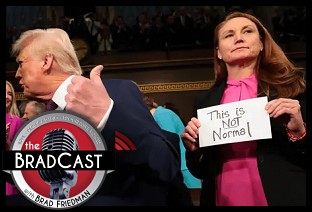 The Longest, Dullest, Most Lie-Filled 'SOTU' Ever: 'BradCast' 3/5/25
The Longest, Dullest, Most Lie-Filled 'SOTU' Ever: 'BradCast' 3/5/25 Trump Bad for Biz... and Farmers... and Nat'l Parks... and...: 'BradCast' 3/4/25
Trump Bad for Biz... and Farmers... and Nat'l Parks... and...: 'BradCast' 3/4/25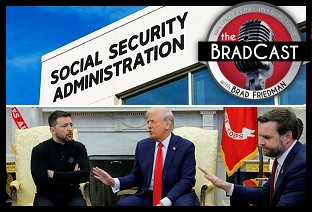 Trump Targeting 50% Cuts, Office Closures at Social Security: 'BradCast' 3/3/25
Trump Targeting 50% Cuts, Office Closures at Social Security: 'BradCast' 3/3/25
 VA GOP VOTER REG FRAUDSTER OFF HOOK
VA GOP VOTER REG FRAUDSTER OFF HOOK Criminal GOP Voter Registration Fraud Probe Expanding in VA
Criminal GOP Voter Registration Fraud Probe Expanding in VA DOJ PROBE SOUGHT AFTER VA ARREST
DOJ PROBE SOUGHT AFTER VA ARREST Arrest in VA: GOP Voter Reg Scandal Widens
Arrest in VA: GOP Voter Reg Scandal Widens ALL TOGETHER: ROVE, SPROUL, KOCHS, RNC
ALL TOGETHER: ROVE, SPROUL, KOCHS, RNC LATimes: RNC's 'Fired' Sproul Working for Repubs in 'as Many as 30 States'
LATimes: RNC's 'Fired' Sproul Working for Repubs in 'as Many as 30 States' 'Fired' Sproul Group 'Cloned', Still Working for Republicans in At Least 10 States
'Fired' Sproul Group 'Cloned', Still Working for Republicans in At Least 10 States FINALLY: FOX ON GOP REG FRAUD SCANDAL
FINALLY: FOX ON GOP REG FRAUD SCANDAL COLORADO FOLLOWS FLORIDA WITH GOP CRIMINAL INVESTIGATION
COLORADO FOLLOWS FLORIDA WITH GOP CRIMINAL INVESTIGATION CRIMINAL PROBE LAUNCHED INTO GOP VOTER REGISTRATION FRAUD SCANDAL IN FL
CRIMINAL PROBE LAUNCHED INTO GOP VOTER REGISTRATION FRAUD SCANDAL IN FL Brad Breaks PA Photo ID & GOP Registration Fraud Scandal News on Hartmann TV
Brad Breaks PA Photo ID & GOP Registration Fraud Scandal News on Hartmann TV  CAUGHT ON TAPE: COORDINATED NATIONWIDE GOP VOTER REG SCAM
CAUGHT ON TAPE: COORDINATED NATIONWIDE GOP VOTER REG SCAM CRIMINAL ELECTION FRAUD COMPLAINT FILED AGAINST GOP 'FRAUD' FIRM
CRIMINAL ELECTION FRAUD COMPLAINT FILED AGAINST GOP 'FRAUD' FIRM RICK SCOTT GETS ROLLED IN GOP REGISTRATION FRAUD SCANDAL
RICK SCOTT GETS ROLLED IN GOP REGISTRATION FRAUD SCANDAL VIDEO: Brad Breaks GOP Reg Fraud Scandal on Hartmann TV
VIDEO: Brad Breaks GOP Reg Fraud Scandal on Hartmann TV RNC FIRES NATIONAL VOTER REGISTRATION FIRM FOR FRAUD
RNC FIRES NATIONAL VOTER REGISTRATION FIRM FOR FRAUD EXCLUSIVE: Intvw w/ FL Official Who First Discovered GOP Reg Fraud
EXCLUSIVE: Intvw w/ FL Official Who First Discovered GOP Reg Fraud GOP REGISTRATION FRAUD FOUND IN FL
GOP REGISTRATION FRAUD FOUND IN FL


































